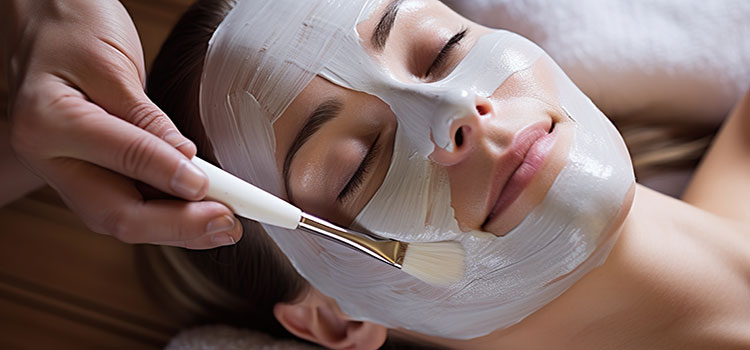Your guide to completing and enrolling in esthetician school

As tradespeople that fall under the umbrella of cosmetology—which includes other beauty professionals like barbers, hair stylists, manicurists and the like—estheticians require a specific education in order to learn their craft.
To work as an esthetician, you need to be licensed by your state. Licensure requirements can vary, but all estheticians must complete an approved esthetician or cosmetology education program to qualify. Beauty school programs are a common option, but some two-year colleges offer associate degrees or certificate programs in esthetics or cosmetology as well.
No matter what type of academic program they choose, esthetician students learn the basics of dermal anatomy and physiology, skincare treatments and business fundamentals. These programs also provide students the chance to practice these skills extensively to prepare them for the workforce after graduation.
In This Article
Explore your options: degrees vs. esthetician programs
Traditional programs
Beauty schools, community colleges, technical colleges or similar institutions can all offer esthetician programs. They can last several months long to over a year depending on the length of the program. Program lengths can vary because states have different requirements for how many hours of instruction an esthetician must complete to be eligible for licensure. Most states require around 600 hours of instruction, but some require fewer or more. As such, the programs you find in a given state should generally reflect their licensing laws, but many schools offer programs which go beyond their state’s minimum licensing laws. Some even directly prepare students for certifications offered by the National Coalition of Estheticians Association (NCEA) or CIDESCO.
Beauty schools, community colleges, technical colleges or similar institutions can all offer esthetician programs.
There are a few differences between esthetician programs offered by beauty schools versus collegiate institutions. For starters, an esthetician program at a community college is usually offered through a certificate program or associate degree, meaning they may award college credit. In addition, beauty schools usually have fewer (if any) prerequisites for admission, whereas most community colleges require that you be accepted into the college first and complete some general education courses before you start your esthetician classes.
The type of institution offering a program does not necessarily indicate whether one program is better than the other, however—so long as the program you choose satisfies your state’s licensing requirements and meets your professional goals, either type of school can have excellent programs.
Some vocational high schools even have cosmetology and/or esthetic programs for students that can satisfy their state’s licensing requirements.
Apprenticeships
Many states also allow estheticians to complete an apprenticeship for the education portion of their licensure requirements. Apprenticeships place you under the tutelage of an experienced professional to learn the ins and outs of their trade and prepare you for the workforce.
In many cases, apprenticeships place a greater focus on hands-on learning than the more structured learning environment of a beauty school or collegiate program. Another thing that differentiates apprenticeships is that they usually pay apprentices, rather than the other way around. In some cases, you may get paid to earn hours in a licensed apprentice training salon
Keep in mind that most states that allow estheticians to learn as apprentices require that the apprenticeship last longer than a typical esthetician education program.
If you are interested in an apprenticeship, contact your state’s esthetician licensing authority to find approved apprenticeships where you live.
Esthetician curriculum: honing your skills
An esthetician program’s course of study can be a little different depending on the institution as well as any relevant scope of practice laws in the state that dictate which kinds of services estheticians can and cannot perform.
At any rate, esthetician programs are designed to equip students with the knowledge and skills necessary to provide high-quality skincare services to their clients. In most programs, you can expect to learn the following:
Combination of theory and practice
Esthetician programs are made up of a combination of classroom learning and hands-on practice. Practicing these techniques on your own is vital to learning the trade and fostering the skills you need to pass any state licensure examinations, many of which include a practical component.
“For beauty school as a whole, your state has certain requirements that you have to learn. In Washington, estheticians are expected to have a certain amount of hours in facials, in waxing, in eyelash enhancement, sanitation and disinfection—just to name a few. It’s really up to the school and how deep they want to go into that,” said Brenda Groce, Director of Northwest Esthetics Academy in Kennewick, Washington.
Things to keep in mind when choosing your esthetician school
When looking for an esthetician program that works for you, be sure to explore their curriculum and ask questions to get a good understanding of what you’ll learn. Groce said that some schools just cover the basics and don’t take as much time to explore learning the very latest technologies and trends, which may leave some students disappointed.
“A lot of times if you want to specialize in something, you might not really get into that specialty at your school depending on where you go. You may have to go and further your education and take more classes. Schools sometimes just teach you what the state requires for you to pass your [licensing exam], which isn’t necessarily a bad thing,” Groce said. “You just might not learn as much as you’re hoping.”
Are there prerequisites for esthetician programs?
Most applicants simply need a high school diploma or equivalent education, such as a GED, to be admitted into esthetician education programs. Programs at community colleges may require that you apply to the college first and take a few general education courses (like English and math) before you can start your esthetician coursework, but this is not always the case.
Become licensed: path to your career
Most states require esthetician graduates to take and pass a written and practical licensing examination. Completing your education and passing any relevant exams are usually all you need to do before applying for an esthetician license but be sure to double-check with your state’s licensing authority to find out if there are any other requirements.
“Every state is a little bit different. For an esthetician in Washington, you have to take a theory examination which is online, and then you have to take a practical examination which is showing different skills in front of proctors,” Groce said.
How long is esthetician school?
This depends on your state’s laws. Most states require estheticians to complete an approved education or apprenticeship program lasting at least 600 or more hours. That typically takes upwards of six months to over a year to complete, but some may be shorter. If you take part in a part-time program, then it could last even longer.
Once your education is complete, and before you start earning an esthetician salary, you need to apply to take your state’s licensing exam(s) right away. Between the time it takes to schedule your test, take the test, submit your application for licensure and wait for the application to be processed, it can take a few more weeks. Once you’re issued your license, you can begin working as an esthetician.
Most states require estheticians to complete an approved education or apprenticeship program lasting at least 600 or more hours.
Are online esthetician schools available?
Some esthetician programs allow you to complete the classroom portion of your studies online. However, it must be noted that estheticians need tactical practice to master their techniques and be ready to provide quality care to clients. Any program that boasts a 100% online learning format should be avoided as these kinds of online courses typically only teach a specific skill or topic. Furthermore, they aren’t typically offered by accredited institutions. In all likelihood, they won’t qualify as an acceptable education program needed for licensure.
How much does esthetician school cost?
Esthetic program costs can vary significantly depending on several factors such as the length of the program and the location. Additional fees, textbooks and cosmetology supplies can also contribute to the cost of your education. Most esthetician programs range from about $5,000 to $15,000 in total.
Financial aid could help ease the cost of schooling. Accredited schools, from technical to community colleges and even beauty schools, should be able to accept federal financial aid through programs like the Free Application for Federal Student Aid (FAFSA). If you aren’t sure whether a school is eligible for federal financial aid, check with the school or the FAFSA directly.
Life after esthetician school: Continuing education
Continuing education (CE) is an essential component of an esthetician’s career. Even though most states don’t require estheticians to complete CE in order to maintain their license, professionals in the field highly encourage all estheticians to take it upon themselves to keep learning through additional classes, seminars and webinars, conferences, trade shows and more. This can help keep you abreast of the latest trends and advancements in the field.
Susanne S. Warfield, Founder and Executive Director of the NCEA, said that continuing education can be especially important to learn about procedures that may not be in your state’s scope of practice.
“Certainly having knowledge of new technologies is important. So even if you can’t perform laser, but look, Sally comes into your salon or spa and says, ‘Oh, I just had laser done on my face.’ Well, that’s going to be a clue that you’re not going to do a chemical exfoliation treatment,” Warfield said. “It became more and more evident that estheticians needed to know about these procedures in order to keep the consumer safe by knowing what the precautions and contraindications to treatment were for that particular service.”
“To anyone that is going out into the field, just remember to continue your education,” Groce said. “Take your time in school, be patient with yourself, be kind to yourself. It goes by really fast. You’re going to learn the most when you’re working in the field, so just keep learning, go to trade shows, perfect your craft, fuel your passion and keep going.”

Written and reported by:
Kendall Upton
Staff Writer

With professional insight from:
Brenda Groce, Director
Northwest Esthetics Academy

With professional insight from:
Susanne S. Warfield, Founder and Executive Director
National Coalition of Estheticians Association (NCEA)
